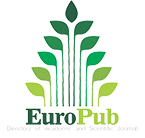Vol. 9 No. 1 (2026): Publishing
Table of Contents
by Sajal Suhane, Rushali Rajaram Katkar, Smita Suhane, S. Sugumaran, Santosh Bhauso Takale, Surekha Dehu Khetree, Shyamsing Thakur, Shital Yashwant Waware, Anant Sidhappa Kurhade
2026,9(1);
87 Views
Abstract
The increasing complexity of bio-energy systems is a reason for the need of advanced analytical methods to enhance resource utilization, process stability and environmental performance. AI methods are popular in this domain, but many papers neglect concerns around data quality, interpretability, scalability and the low generalization potential of models toward plants and feedstocks different from those they were trained on. This paper intends to offer a systematic review on AI techniques available for biomass resource assessment, conversion-process optimization, and supply-chain planning and emission management. The review is structured adopting a rigorous review approach focusing on model, data set, optimization framework and hybrid method developed in the scope of bio-energy value chain. Highlights – The key findings are that AI improves the prediction of biomass availability and biogas/syngas yields, of feedstock properties and emission behavior; surrogate and hybrid models result in expedited simulation time and facilitate real-time decision making. The review also highlights an emerging trend with digital twins, remote sensing with application of machine learning, and federated learning in multi-plant optimization. These findings also have important implications for researchers, engineers and policy-makers who aim to develop robust low emissions bio-energy systems that are economically feasible.
show more
by Ali Hayder Hamzah, Hussein Odia, Hamed A. Gatea, Maithm A. Obaid, Alzahraa S. Abdulwahid, Hadil Hussain Hamza, Mohannad Abdulrazzaq Gati, Aseel M. aljeboree, Ayad F. Alkaim, Ali Aqeel Mahmood
2026,9(1);
20 Views
Abstract
We present a computational investigation of Gefitinib, a clinically approved EGFR inhibitor, and Quercetin, a bioactive flavonoid with anticancer potential, through an integrated density functional theory (DFT), time-dependent DFT (TD-DFT), and molecular docking framework. Geometry optimization at the B3LYP/6-31G(d,p) level yielded electronic and global reactivity descriptors, providing insights into molecular stability and interaction potential. Quercetin exhibited higher electronic stability, with a HOMO–LUMO gap of 5.22 eV compared to 4.24 eV for Gefitinib. TD-DFT simulations predicted key absorption bands at ~369 nm for Gefitinib and ~310 nm for Quercetin, correlating with their distinct electronic transitions. Docking studies against the EGFR tyrosine kinase domain (PDB: 4HJO) revealed stronger predicted binding for Quercetin (−8.9 kcal/mol) than Gefitinib (−5.5 kcal/mol), supported by hydrogen bonding and π–π stacking interactions. These findings highlight how computational chemistry techniques, widely applied in materials design and process optimization, can also provide multiscale insights into drug–target interactions. By integrating electronic structure analysis with molecular docking, this study demonstrates a transferable approach relevant to applied chemical engineering, bridging quantum chemistry with molecular interaction studies in pharmaceutical and materials science contexts.
show more
by Hala Hussain Kareem, Ahmed Hussein Ahmed, Abdul_mohsen Naji Al-mohesen, Issa Mohammed Kadhim, Muntadher Abed Hussein, Nour Mohamd Rasla, Muntadher Kadhem Sultan, Duha Abed Almuhssen Muzahim, Mustafa S. Shareef
2026,9(1);
20 Views
Abstract
The performance and longevity of polymer filaments in Fused Deposition Modeling Additive Manufacturing (FDM-AM) are highly dependent on their chemical and thermal stability, which can be significantly enhanced by the incorporation of functional additives. This study explores the role of stabilizers, plasticizers, nanofillers, and antioxidant agents in improving the structural integrity and printability of common polymers such as polylactic acid (PLA), polyethylene terephthalate glycol (PETG), and acrylonitrile butadiene styrene (ABS). Analytical chemistry techniques, including Fourier-transform infrared spectroscopy (FTIR), thermogravimetric analysis (TGA), differential scanning calorimetry (DSC), and gel permeation chromatography (GPC), are reviewed and applied as critical tools to evaluate molecular interactions, degradation kinetics, and additive dispersion within the polymer matrix. Results highlight that additives not only suppress thermo-oxidative degradation and moisture sensitivity but also influence glass transition behavior, crystallinity, and filament rheology, ultimately leading to improved dimensional accuracy and mechanical performance in printed parts. This work provides a comprehensive framework for correlating chemical stability with processing reliability in FDM-AM, offering insights for the development of next-generation, high-performance, and durable polymer filaments tailored for sustainable and industrial applications.
show more
by Smita Desai, Sushama Shirke, Vishvas V. Kalunge, Sireesha Koneru, Gaurav Raju Khobragade, Vidhi Rajendra Kadam, Shyamsing Thakur, Govindarajan Murali, Anant Sidhappa Kurhade
2026,9(1);
89 Views
Abstract
Biomass resource mappings are essential tasks for sustainable energy planning, since it offers information on the potential supply, geographical availability of resources, plant sitting, transportation opportunities and roadmap towards long term renewable energy concepts that have policy relevance. Its relevance is increasing as countries are embracing low carbon economy’s roadmaps which demand for reliable spatial quantitative estimations of forest and waste residues – based biomass potentials. Despite the significant headway, there are still some loopholes in applying remote sensing and machine learning techniques. These limitations comprise scarcity of good quality field data for model calibration, poor integration of socio–economic drivers and difficulties in representing fine–scale spatial variability that hinder accurate estimate of yields at different spatial levels. This paper surveys recent machine learning methods for AGB estimation, discusses their methodological limitations, and proposes future research avenues toward scalable and robust forest biomass mapping. A combination of satellite observations, GIS–based layers and ground inventory data sets are included in the analysis as well as a variety of regression, tree based, kernel based, neural network, deep learning and hybrid modelling approaches over various land coverage areas. According to the previous works, evidence is gathered from the surveyed studies that ensemble and deep learning approaches can enhance prediction performance on multi–source data; GIS–machine learning integration contributes to better site selection and logistics analysis. The results also demonstrate the potential for a combined framework that exploits transfer learning approaches and digital twin methodologies to reduce prediction uncertainty, especially in low–data areas. Such information could help support rational decision–making activities for policymakers, planners and industry actors that consider the role of bioenergy in national energy security, climate change mitigation strategies, resource sustainability and long–term renewable energy planning.
show more
by Uday Abdul-Reda Hussein, Hayder Hamid Abbas Al-Anbari, Abed J. Kadhim, Fadhil M. Abid, Aseel M. Aljeboree, Ayad F. Alkaim
2026,9(1);
26 Views
Abstract
The adsorption of the potentially toxic industrial dyes, Acid Red 18 (AR18), Acid Yellow 23 (AY23), Reactive Yellow 84 (RY84), and Reactive Black 5 (RB5). was assessed in this work using non-activated and activated sunflower seed husks as environmentally sound adsorbents. Hydrochloric, phosphoric and sulfuric acids activated the sunflower seed husk, and the best chemical activation method was determined by surface morphology and the adsorption performance. The optimal temperature for thermal treatment to convert biomass into activated carbon has been established. The structural and chemical characteristics of the adsorbents were investigated by the characterization techniques such as Field Emission Scanning Electron Microscopy (FESEM), Energy Dispersive X-ray Spectroscopy (EDX), Transmission Electron Microscopy (TEM), and Fourier-Transform Infrared Spectroscopy (FTIR). The percentage removals of Reactive Yellow, Reactive Black 5, Acid Red, and Acid Yellow 23 were determined to be (95.02%, 90.00%, 85.00% and 70.00% for the acid-activated sunflower seed husks. These values were significantly higher than the adsorption capacities of non-activated husks, 80.02%, 75.27%, 55.70%, and 45.00%, respectively, for the corresponding dyes. The findings demonstrate an improvement in the properties of acid-activated sunflower seed husks in the adsorption of dyes (Reactive Black 5 and Acid Red), reflecting the influence of acid activation on expansion of the specific surface area and availability of functional groups. Adsorption efficiency was highest under acidic conditions due to enhanced electrostatic attraction between the adsorbent surface and dye molecules. Reactive dyes showed greater sensitivity to pH variation, with efficiency dropping sharply in alkaline media. In contrast, Acid dyes—particularly Acid Yellow—retained higher performance across the pH range, indicating additional binding mechanisms beyond electrostatic interactions.
show more
by Ali Raqee Abdulhadi, Aqeel Al-Hilali, Al-Dily Kareem, Hayder Hamid Abbas Al-Anbari, Salah Abdulhadi Salih, Ammar S. Al Khafaji, Sameh Hussein Hamo, Duha Abed Almuhssen Muzahim, Shurooq Sabah Hussein
2026,9(1);
23 Views
Abstract
The release of volatile organic compounds (VOCs) during fused deposition modeling additive manufacturing (FDM-AM) has become a critical concern due to its implications for occupational health, indoor air quality, and material performance. In this study, a quantitative chromatographic analysis was conducted to characterize and evaluate VOC emissions from commonly used thermoplastic filaments during FDM-AM. Gas chromatography coupled with mass spectrometry (GC–MS) was employed to separate and identify volatile fractions, while flame ionization detection (FID) provided quantitative assessment of emission concentrations. Representative results revealed the presence of styrene, ethylbenzene, formaldehyde, acetaldehyde, and other low-molecular-weight aldehydes and ketones, with emission profiles varying significantly across polymer types such as ABS, PLA, and PETG. Peak intensities correlated strongly with extrusion temperature, suggesting that process parameters directly influence VOC release. Comparative analysis indicated that ABS exhibited the highest emission intensity, dominated by aromatic hydrocarbons, while PLA produced lower total VOCs but higher proportions of lactide-derived species. The findings underscore the necessity of systematic monitoring of VOCs in FDM-AM environments and provide quantitative evidence for optimizing process conditions and implementing adequate ventilation systems. This work establishes a framework for linking chromatographic signatures of volatile compounds with material choice and processing parameters, contributing to safer and more sustainable additive manufacturing practices.
show more









 Open Access
Open Access